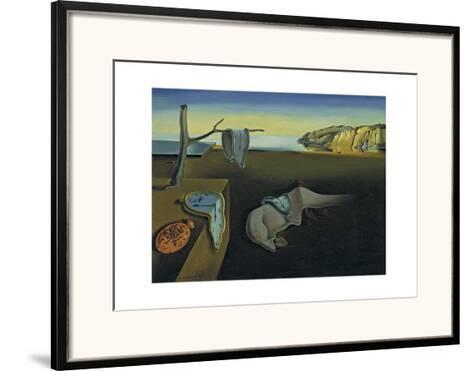
The distorted human visage from the original painting is beginning to morph into another of the strange fish floating above it.


The hands of the watches float above their dials, with several conical objects floating in parallel formations encircling the watches. The dead olive tree from which the soft watch hangs has also begun to break apart. Behind the bricks, the horns receding into the distance symbolise atomic missiles, highlighting that despite cosmic order, humanity could bring about its own destruction. These represent the breakdown of matter into atoms, a revelation in the age of quantum mechanics. The plane and block from the original is now divided into brick-like shapes that float in relation to each other, with nothing binding them. The landscape of Cadaqués is now hovering above the water. Disintegration depicts what is occurring both above and below the water's surface. In this version, the landscape from the original work has been flooded with water. It was originally known as The Chromosome of a Highly coloured Fish's Eye Starting the Harmonious Disintegration of the Persistence of Memory, and first exhibited at the Carstairs Gallery in New York in 1954. It is a 1954 re-creation of the artist's famous 1931 work The Persistence of Memory, and measures a diminutive 25.4 × 33 cm. La Desintegración de la Persistencia de la Memoria or The Disintegration of the Persistence of Memory is an oil on canvas painting by the Spanish surrealist Salvador Dalí. Another question I would have is on how Dali managed to get inspiration for this painting.The Disintegration of the Persistence of Memory Also, why is “time” in the painting apparently rotting? The ants and the fly on the clocks are puzzling. One question I would have for Dali is what the ants on the golden watch symbolized. I also love seeing and traveling to beautiful landscapes, like the one portrayed in the painting, in real life and so that also drew me to the painting. It was not until I read about the painting that I realized that the grey figure was a face I thought it had been a lying elephant or a simple blanket on the ground. What drew me to this piece outright was the bizarre appearance of the grey figure and the pizza-like clocks slouching on objects. “The Persistence of Memory” in the MoMa was among other apparently Modernistic paintings. The juxtaposition of the tree, clocks, face, watch, and ants with the background are another indicator of surrealism in the painting. The painting also shows some cubism aesthetics like the edges surrounding the sea and the ground under the tree. Aspects of the face are thought-provoking or even repulsive like the unusually long eye-lashes, the giant nose, and what appears to be a tongue just under the nose many still question this “tongue” and believe it to be other things including saliva.

The disfigured face on the ground naturally appears confusing to the average person. This painting strongly portrays the aesthetic preferences of modernism because of its imaginative qualities of surrealism. The painting also has realistic cliffs in the background that are similar to those found in Spain near Dali’s home and which, along with the sea, are perhaps the only realistic features in the painting. The painting consists of a deformed face on the seemingly desert ground, ants on a gold watch, and three melting clocks resembling pizza dough on top of the face, a tree branch, and next to the gold watch. “The Persistence of Memory” is a landscape painting with surrealistic and cubism attributes. Dali was nonetheless flamboyant in nature and was perceived by many to have been crazy. He is also known for being a versatile artist being involved in several fields like sculpture, printmaking, fashion, advertising, writing, and filmmaking for which he famously collaborated with Alfred Hitchcock.

Dali is best known for his contributions to realism including his “Paranoiac-Critical method” which he used to access the subconscious part of his mind in order to gain inspiration for his art. Dali was born on in Figueres, Spain and died on Januin the same town. Salvador Dali was a 19 th century artist who was associated with the surrealist movement during his career.


 0 kommentar(er)
0 kommentar(er)
